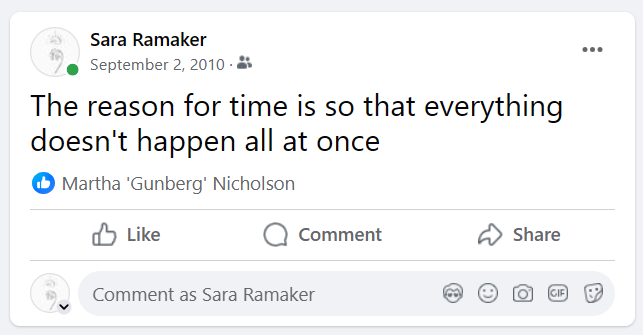By Sara Ramaker
What was your go-to outfit in 2010 and, more importantly, what did you post about on social media back then? If you’re not cringing in self-reflection, allow me to humiliate myself for the sake of professional soul-bearing.

What was I posting about, why did I post it, and why was my now-boss Martha Nicholson at LKF the only one to like it?
While I don’t know the answer to those questions, I am happy to report that my social posting game has majorly evolved since 2010, as has the entire field of content marketing.
The Former State of Content Marketing
Content marketing began to evolve in the 2010s from a niche concept to a fundamental strategy to what is now an essential part of successful marketing efforts today.
What we now know as content marketing began to take shape during the digital revolution of the early 2000s. The advent of the internet provided brands and businesses with new platforms to reach broader audiences by creating websites, blogs, and email newsletters. The concept was simple: provide valuable content that meets the needs of your audience, and in return, they’ll reward you with their loyalty and business.
The early 2010s was a pivotal period for content marketing, marked by the explosive growth of social media platforms like Facebook, Twitter (now known as X), and later, Instagram and LinkedIn. These platforms provided marketers with the tools to share content directly with consumers, fostering direct engagement and brand recognition and loyalty that were previously unattainable.
Brands quickly recognized the potential, and the race to create shareable, engaging content in a variety of forms was on.
During this time, the content marketing landscape was characterized by the rise of blogs, eBooks, and whitepapers. Savvy marketers—including your favorite marketing weirdos at LKF—began focusing on the concept known as inbound marketing, a strategy that revolves around creating valuable content to attract customers organically.
For many of our clients, this shift moved away from
traditional, outbound marketing techniques such as cold calling and TV ads and
toward content-driven strategies designed to pull customers in with new tactics
and delivery methods.
Blogs—sometimes given catchy, alliteration-laden names like Industry Insights ;) —became a cornerstone of content marketing strategies. They allowed brands to establish thought leadership, improve SEO rankings, and drive traffic to their websites. The goal was—and still is—to create content that was not only informative but also optimized for search engines, a practice that led to the rise of the now-familiar term SEO or search engine optimization.
As marketers, we continue to focus on creating keyword-rich content to ensure blogs rank highly on Google, driving organic traffic and increasing brand visibility.
Social media platforms played a crucial role in the rise of content marketing. By the early 2010s, Facebook had surpassed 500 million users. Marketers quickly realized the potential of these platforms to distribute content, engage with audiences, and build communities around their brands.
The rise of social media influencers also began in this era. Brands partnered with popular figures on platforms like YouTube and Instagram to reach niche audiences in authentic ways. This practice laid the foundation for influencer marketing, a strategy that continues to thrive today.
Evolving Techniques & Best Practices
As content marketing matured, so did the best practices surrounding it. The early focus on quantity—producing as much content as possible—gradually shifted to quality. Google’s algorithm updates, such as Panda in 2011, penalized low-quality content, forcing marketers to prioritize creating high-value, relevant content that genuinely met the needs of their audiences.
Storytelling emerged as a powerful tool in content marketing. Brands began to realize that consumers connected more deeply with content that told a story, rather than simply promoting a product. This era saw the rise of branded content that focused on narrative and emotional connection, such as Coca-Cola’s “Share a Coke” campaign in 2011, which personalized bottles with names, encouraging social sharing, creating a sense of community, and driving buyer demand. The successful campaign was also revived in 2017.
Another key development was the integration of data analytics into content marketing. Marketers began using tools like Google Analytics and social media insights to track content performance and refine their strategies. This data-driven approach allowed for more targeted and personalized content, increasing the effectiveness of campaigns.
Staying Relevant Today
Fast forward to today, where content marketing remains as relevant as ever despite a complex landscape. With the proliferation of digital channels, marketers must navigate an increasingly fragmented media environment. Video content, podcasts, and interactive experiences have joined the ranks of blogs and social media posts as essential components of a content strategy.
One of the most significant shifts in recent years is the emphasis on personalization. Modern consumers expect content tailored to their preferences, which has led to the rise of AI-driven content recommendations and dynamic content that changes based on user behavior.
Moreover, the importance of authenticity has never been greater. Consumers today are savvy and can easily discern between genuine content and inauthentic marketing ploys. Brands that prioritize transparency, ethics, and social responsibility in their content are more likely to build lasting relationships with their audiences.
At LKF, we’ve taken our content marketing efforts to new heights, literally, with the introduction of in-house drone work thanks to our drone, affectionately known as Amelia AirHart, and her captain, LKF’s Digital Media Designer Carrie Largent.
Professionally, we’re innovative and collaborative as we continually dedicate ourselves to designing and innovating content that reaches our clients’ audiences and objectives simultaneously.
Personally, I no longer post vague, unrelatable content on social media. Instead, 95% of my Instagram posts feature photos of my dog along with anecdotal stories and witty hashtags summarizing our daily adventures. I am happy to report that I get likes from more than just Martha these days. All it took was sharing the things that make me happy authentically—and pimping out my pretty pittie—to do so.


